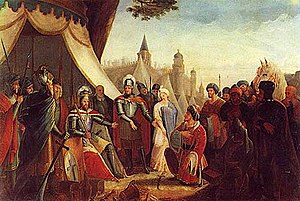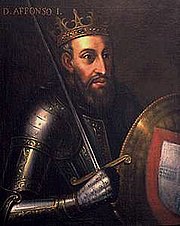Siege of Lisbon: Difference between revisions
m + coor from es:Sitio de Lisboa |
Indianwhite (talk | contribs) mNo edit summary |
||
| (One intermediate revision by the same user not shown) | |||
| Line 6: | Line 6: | ||
|date=[[July 1]] – [[October 24]], [[1147]] |
|date=[[July 1]] – [[October 24]], [[1147]] |
||
|place=[[Lisbon, Portugal]] |
|place=[[Lisbon, Portugal]] |
||
|result=Decisive Portuguese |
|result=Decisive Portuguese-Crusader-Christian victory |
||
|combatant1=[[Image:PortugueseFlag1143.svg|22px|border]] [[Portugal]]<br>[[File:Cross-Pattee-red.svg|20px]] [[Crusade]]rs |
|combatant1=[[Image:PortugueseFlag1143.svg|22px|border]] [[Portugal]]<br>[[File:Cross-Pattee-red.svg|20px]] [[Crusade]]rs |
||
|combatant2=[[Moors]] |
|combatant2=[[Moors]] |
||
|commander1=[[Afonso I of Portugal]]<br>[[Henry Glanville]], [[Arnold III of Aerschot]], [[Christian of Ghistelles]], [[Simon of Dover]], [[Andrew of London]], [[Saher of Archelle]] |
|commander1=[[Afonso I of Portugal]]<br>[[Henry Glanville]], [[Arnold III of Aerschot]], [[Christian of Ghistelles]], [[Simon of Dover]], [[Andrew of London]], [[Saher of Archelle]] |
||
|commander2=Unknown |
|commander2=Unknown |
||
|strength1= |
|strength1='''13,000 men:''' |
||
*6,000 English |
*6,000 English |
||
*5,000 Germans |
*5,000 Germans |
||
*2,000 Flemish |
*2,000 Flemish<br> |
||
200 ships |
|||
|strength2= |
|strength2= about 7,000 men |
||
|casualties1= |
|casualties1= about 2,000 killed |
||
|casualties2= |
|casualties2= about 2,000 killed |
||
}} |
}} |
||
{{Campaignbox Reconquista}} |
{{Campaignbox Reconquista}} |
||
Revision as of 12:44, 19 May 2009
| Siege of Lisbon | |||||||
|---|---|---|---|---|---|---|---|
| Part of the Reconquista and the Second Crusade | |||||||
 The Siege of Lisbon by D. Afonso Henriques by Joaquim Rodrigues Braga (1840): a Romantic view | |||||||
| |||||||
| Belligerents | |||||||
|
| Moors | ||||||
| Commanders and leaders | |||||||
|
Afonso I of Portugal Henry Glanville, Arnold III of Aerschot, Christian of Ghistelles, Simon of Dover, Andrew of London, Saher of Archelle | Unknown | ||||||
| Strength | |||||||
|
13,000 men:
| about 7,000 men | ||||||
| Casualties and losses | |||||||
| about 2,000 killed | about 2,000 killed | ||||||
The Siege of Lisbon, from July 1 to October 25 of 1147, was the military action that brought the city of Lisbon under definitive Portuguese control and expelled its Moorish overlords. The Siege of Lisbon was one of the few Christian victories of the Second Crusade and is seen as a pivotal battle of the wider Reconquista.
The Fall of Edessa in 1144 led to a call for a new crusade by Pope Eugene III in 1145 and 1146. In the spring of 1147, the Pope authorized the crusade in the Iberian peninsula. He also authorized Alfonso VII of León to equate his campaigns against the Moors with the rest of the Second Crusade. In May 1147, the first contingents of crusaders left from Dartmouth in England for the Holy Land. Bad weather forced the ships to stop on the Portuguese coast, at the northern city of Porto on 16 June 1147. There they were convinced to meet with King Afonso I of Portugal.
The crusaders agreed to help the Count attack Lisbon, with a solemn agreement that offered to the crusaders the pillage of the city's goods and the ransom money for expected prisoners. The siege began on 1 July. After four months, the Moorish rulers agreed to surrender on 24 October, primarily due to hunger within the city. Most of the crusaders settled in the newly captured city, but some of the crusaders set sail and continued to the Holy Land. Lisbon eventually became capital city of the Kingdom of Portugal, in 1255.
Second Crusade
The Fall of Edessa in 1144 led to a call for a new crusade by Pope Eugene III in 1145 and 1146. In the spring of 1147, the Pope also authorized a crusade in the Iberian peninsula, where the war against the Moors had been going on for hundreds of years.[1]
At the beginning of the First Crusade in 1095, Pope Urban II had urged Iberian crusaders (Portuguese, Castilians, Leonese, Aragonese and others) to remain at home, where their own warfare was considered just as worthy as that of crusaders travelling to Jerusalem.
Eugene III encouraged Marseille, Pisa, Genoa, and other Mediterranean cities to fight in Iberia. He also authorized Alfonso VII of León to equate his campaigns against the Moors with the rest of the Second Crusade.[2]
On 19 May 1147 the first contingents of crusaders left from Dartmouth in England, consisting of Flemish, Frisian, Norman, English, Scottish, and some crusaders from Cologne,[3] who collectively considered themselves "Franks".[4]
No prince or king led this part of the crusade, England at the time was in the midst of The Anarchy. The fleet was commanded by Henry Glanville, Constable of Suffolk.[5][6] Other crusader captains included Arnold III of Aerschot, Christian of Ghistelles, Simon of Dover, Andrew of London, and Saher of Archelle.[7]
Redirected efforts
According to Odo of Deuil there were 164 ships bound for the Holy Land, and there may have been as many as 200 by the time they reached the Iberian shore.
Bad weather forced the ships to stop on the Portuguese coast, at the northern city of Porto on 16 June 1147. There they were convinced by the bishop, Pedro II Pitões, to meet with King Afonso of Portugal.
The King, who had reached the Tagus River and conquered Santarém in March, had also been negotiating with the Pope for the recognition of his title of King.
He was notified of the arrival of a first party and hastened to meet them.[5]
The undisciplined multi-national group agreed to help him there, with a solemn agreement that offered to the crusaders the pillage of the city's goods and the ransom money for expected prisoners.
For the city, "they shall have it and hold it until it has been searched and despoiled, both of prisoners for ransom and of everything else. Then, when it has been as thoroughly searched as they wish, they shall turn it over to me..."[8]
Afonso promised to divide the conquered territories as fiefs among the leaders. He reserved the power of advocatus and released those who were at the siege and their heirs trading in Portugal from the commercial tax called the pedicata.
The English crusaders were at first unenthusiastic, but Henry Glanville convinced them to participate.[9] Hostages were exchanged as sureties for the oaths.[5]

Fall of Lisbon
The siege began on 1 July. The Christians soon captured the surrounding territories and besieged the walls of Lisbon itself, although the Muslim defenders were able to destroy their siege engines.
After four months, the Moorish rulers agreed to surrender (21 October), primarily due to hunger within the city, which was sheltering populations displaced from Santarém as well as "the leading citizens of Sintra, Almada, and Palmela."[10]
After a brief riotous insurrection the Anglo-Norman chronicler attributes to "the men of Cologne and the Flemings", the city was entered by the Christian conquerors, on 25 October.
The terms of the surrender indicated that the Muslim garrison of the city would be allowed to keep their lives and property, but as soon as the Christians entered the city these terms were broken.[5]
According to the Expugnatione Lyxbonensi,
The enemy, when they had been despoiled in the city, left the town through three gates continuously from Saturday morning until the following Wednesday. There was such a multitude of people that it seemed as if all of Hispania were mingled in the crowd.[8]
Aftermath
Most of the crusaders settled in the newly captured city, and Gilbert of Hastings was elected bishop, but some of the crusaders set sail and continued to the Holy Land.[5]
In spite of the contractual nature of the city's surrender, a legend arose that the brave Portuguese warrior and nobleman, Martim Moniz, sacrificed himself in order to keep the city doors open to the conquering Christian armies.
Lisbon eventually became capital city of the Kingdom of Portugal, in 1255.
The victory was a turning-point in the history of Portugal and the wider Reconquista, which would be completed in 1492.[11]
In Fiction
The siege is the central theme in the 1989 novel "The History of the Siege of Lisbon", by Portuguese author José Saramago, which takes a look at the Medieval events from a critical and ironical 20th Century perspective.
See also
Notes
- ^ The traditional start of the Reconquista is identified with the defeat of the Muslims at Covadonga in 722, see Riley-Smith (1990) p.32.
- ^ Riley-Smith (1990) p.48
- ^ Cologne was allied with London in the incipient wool trade: see Steelyard.
- ^ This is the expression consistently used in the eye-witness chronicle of the siege, De expugnatione Lyxbonensi, attributed in the sixteenth century to "Osbernus". The ms, titled "Historia Osberni" by a sixteenth-century annotator, is in the form of a letter, with a superscription "Osb. de Baldr. R salutem" that C. R. Cheney read as to "Osberto de Baldreseie" i.e. Bawdsley, Suffolk, from a certain "R."; see Cheney, C. R. (1932). "The Authorship of the De Expugnatione Lyxbonensi". Speculum. 7 (3): 395–397. ISSN 0038-7134.
{{cite journal}}: Cite has empty unknown parameters:|month=and|coauthors=(help) - ^ a b c d e Runciman (1951), p. 258.
- ^ Henry was a kinsman of Ranulf de Glanvill of Suffolk, Chief Justiciar of England under Henry II; the Norman name derives from Glanville, near Lisieux (DNB, s.v. "Ranulf de Glanvill").
- ^ Phillips (2007), p. 143.
- ^ a b Brundage (1962) pp.97-104
- ^ The prominence of Henry Glanvill has suggested to some readers that Osbernus was an Anglo-Norman cleric with special attachment to him and his house.
- ^ Osbernus, who adds "As a result the basest element from every part of the world had gathered there, like the bilge water of a ship, a breeding ground for every kind of lust and impurity."
- ^ Riley-Smith (1990) p.126.
References
- Runciman, Steven (1952). A History of the Crusades, vol. II: The Kingdom of Jerusalem and the Frankish East, 1100–1187. New York: Cambridge University Press.
{{cite book}}: Cite has empty unknown parameter:|coauthors=(help) - Brundage, James (1962). The Crusades: A Documentary History. Milwaukee, WI: Marquette University Press.
{{cite book}}: Cite has empty unknown parameter:|coauthors=(help) - Riley-Smith, Jonathan (1990). The Atlas of the Crusades. New York: Facts on File. ISBN 0816021864.
{{cite book}}: Cite has empty unknown parameter:|coauthors=(help) - Phillips, Jonathan (2007). The Second Crusade: Extending the Frontiers of Christendom. New Haven, CT: Yale University Press. ISBN 9780300112740.
Further reading
- Odo of Deuil. De profectione Ludovici VII in orientem. Edited and translated by Virginia Gingerick Berry. Columbia University Press, 1948.
- Kenneth Setton, ed. A History of the Crusades, vol. I. University of Pennsylvania Press, 1958.
- Osbernus De expugnatione Lyxbonensi or The Capture of Lisbon On-line excerpt, in English.
